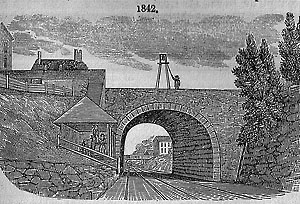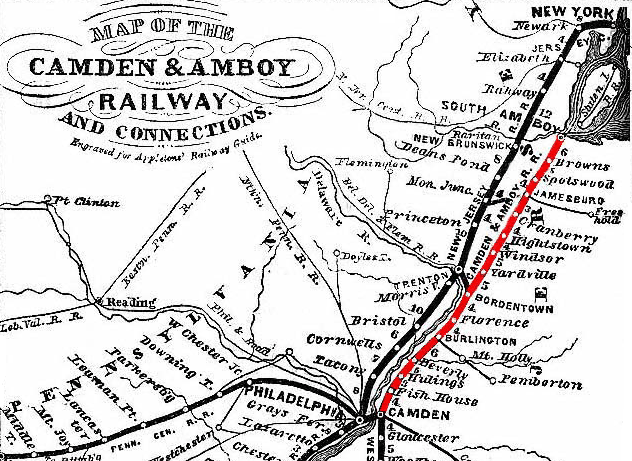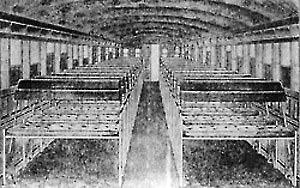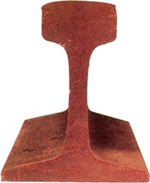
1842 woodcut of Camden & Amboy railroad arch in Bordentown. The bellman alerted the passengers waiting in the shelter below. Credit: From Barber and Howe, Historical Collections of New Jersey Past and Present, 1868
Located between two of the nation’s most important cities, New Jersey has long been an important corridor for the transport of people and goods in the Mid Atlantic region. It seemed inevitable that important developments in transportation would start here, and that the Delaware River would play a key supporting role in that transformation. The New Jersey Legislature chartered the Camden and Amboy Rail Road and Transportation Company (C&A) in February 1830. This was the first railroad in New Jersey and the third in the United States. The C&A’s corporate architect, first president and chief engineer was Robert L. Stevens (1787–1856), who was also the country’s leading builder of steamboats. The new railroad and its sister entity, the Delaware and Raritan Canal Company, were created to service a heavily traveled passenger and freight route across New Jersey. By 1871, when the Pennsylvania Railroad leased the Camden & Amboy, the C&A and its affiliates controlled key rail corridors linking Jersey City and the Hudson River crossing, and South Amboy and lower New York Bay with Camden and Philadelphia.
Chartered on the same day in 1830 as the Camden and Amboy Rail Road, the Delaware and Raritan (D&R) Canal was envisioned as a bulk freight corridor between Philadelphia and New York; it served part of the proposed railroad’s route and loomed as a potential competitor. In February 1831, the New Jersey Legislature approved the partial merger of the railroad and canal companies into an entity known as the Joint Companies. In 1832, the state gave the Joint Companies power to prevent the construction of any other rail line between New York and Philadelphia. In effect, this restraint on competition granted the Joint Companies a monopoly on bulk freight shipped on the canal and on railroad traffic. In return, the state received shares of stock and revenue from transit duties on each passenger and ton of freight. These transit taxes alone constituted as much as twenty percent of the state’s total income and gave the Joint Companies even greater political leverage.

1869 Map of the Camden & Amboy Railway and connections as engraved for “Appletons’ Railway and Steam Navigation Guide” in wikipedia.org.
New Jersey’s first railroad was a strategic business venture by the Stevens family. Based in Hoboken, the Stevens were innovators and transportation entrepreneurs, and were among the first to see the true potential of railroad transport. Robert Stevens was the son of Col. John Stevens (1749–1838), who received the first railroad charter granted in North America in 1815 and experimented with steam locomotives in the 1820s. Like his son, John Stevens was an inventor and engineer who sought more efficient and profitable ways to link land routes across New Jersey with points of navigation on the Delaware River and Raritan Bay. The Stevens were pioneers in the steamboat business and integrated transportation systems. They established the successful Union Line which used a combination of steamboats and stagecoaches to convey passengers and goods between southern Manhattan and Philadelphia. Steamboats brought passengers from Manhattan to the South Amboy docks where connecting stagecoach service to Bordentown was available. At Bordentown, riverboats made the last leg of the trip to Philadelphia. By the 1820s, around 2,000 passengers a week traveled the New York–Philadelphia route. The Camden and Amboy was created as a faster and more comfortable alternative to stagecoaches.

Interior of early C&A passenger car, 1833. Credit: Hagley Museum and Library
Bordentown and South Amboy were intended as the railroad’s primary terminals. Camden was to be used as a terminal when ice on the Delaware prevented steamboats from moving between Bordentown and Philadelphia. In September 1832, the first section of railroad, 14 miles of single track, opened between Bordentown and Hightstown and by December the line reached South Amboy. Teams of horses pulled the first rail carriages; steam locomotives replaced horse-drawn trains in 1833.
In 1834, the southern Bordentown–Camden section of the 61-mile rail line was completed. With the blessing of the Legislature, the C&A absorbed competitors such as the Pennsylvania chartered Trenton and Philadelphia Railroad and added new connecting lines. By 1838, additional routes from Bordentown to Trenton and from Trenton to New Brunswick were up and running. The New Jersey Rail Road and Transportation Company (NJRR), which was controlled by the Joint Companies, built a northern route linking New Brunswick, Newark and Jersey City, where connecting ferry service to Manhattan Island was offered. By 1839, the C&A and its related entities controlled all rail service between Philadelphia and New York. By the early 1860s, C&A routes carried nearly 500,000 passengers each year.

John Bull with cars, Camden and Amboy Railroad. Credit: Hagley Museum and Library
Shortly after the New Jersey Legislature chartered the C&A, Robert Stevens sailed to England to purchase rails and a steam locomotive. During this trip he designed an innovative rolled iron rail that became the standard rail design in the U.S. He also purchased a steam powered locomotive engine from Robert Stephenson & Co. That engine, the John Bull, is now the oldest complete and operable locomotive in the western hemisphere.
In 1831, crates containing components of the new 10-ton steam locomotive arrived at the C&A docks near Bordentown. Isaac Dripps, the C&A’s chief mechanic, was an experienced steamboat mechanic but had never seen a steam locomotive. He managed to reassemble the English engine and introduced important safety modifications in the process: the John Bull became the first locomotive with a bell, headlight, and cowcatcher. The engine’s first public trial run took place that year and amazed onlookers when it reached speeds of 35 to 40 miles per hour. In the words of one transportation historian, it was “the most sophisticated and advanced machine of its time”. In September 1833, the John Bull and other steam locomotives built in the C&A shops began full operation. In these early years, rail travel was still experimental and potentially hazardous. Not long after C&A engines began operating, the first serious railroad accident in the U.S. occurred when a rail car axle broke. Former President John Quincy Adams was on board but not injured.

Example of the revolutionary flanged iron “T” style rail invented by Robert Stevens for the Camden & Amboy Rail Road. howstuffworks.com
During the 1830s, the C&A pioneered important technological innovations in railroad construction, design and operation. The ‘T’ style rail with rolled base designed by Robert Stevens became the industry standard. His innovative design added a broad flanged base to support heavier loads and the rail was shaped so that it could be secured to wood crossties, also known as sleepers, with a hooked spike he invented. The new C&A rail represented a major safety advance over the dangerous and unreliable iron strapped wooden rails then in use. Under Stevens’s guidance, the C&A also introduced prototypes of modern ties and rail connectors as well as pilot wheels for safer operations over spindly tracks. The company’s baggage handling methods pioneered modern freight containerization. The C&A also introduced the first vestibule style passenger cars.
The state charter for the United Companies was to expire in 1869. In 1867, as criticism of the company’s safety record and monopolistic practices grew and competition for profitable rail lines intensified, the Joint Companies attempted another legal maneuver to maintain a dominant market position. The United New Jersey Rail Road and Canal Company (UNJRRCC) was created as an informal alliance of the C&A, the D&R Canal Company and the New Jersey Rail Road and Transportation Company. However, times had changed and railroads were becoming increasingly regional and national in scope. By 1871, the UNJRRCC agreed on favorable terms to lease it holdings to the powerful Pennsylvania Railroad Company, which in turn became one of the nation’s most important transportation companies. The C&A route from Camden to Trenton is now used by New Jersey Transit’s Light Rail River Line, and a portion of the C&A and NJRR routes are part of Amtrak’s Northeast Corridor.
The original route followed by the Camden and Amboy Rail Road is listed in the National Register of Historic Places for its important role in the history of transportation. Although the John Bull was retired from service in1866, it eventually became an icon of American railroad history. The engine was refurbished for exhibition in 1876 at the country’s first international exposition, the U.S. Centennial. In 1885, the locomotive became the first permanent engineering exhibit at the Smithsonian Institution in Washington, D.C., where it has been seen by millions of visitors.
For more information:
- www.nationalregisterofhistoricplaces.com/nj/Burlington/state.html
- www.jcrhs.org/camden&amboy.html
- www.trainweb.org/camdenandamboyrrhistoricalgroup
- www.rrmuseumpa.org/education/historytimeline1.shtml
- www.archive.org/details/leadingamericani00ilesrich
- inventors.about.com/library/inventors/bl_john_stephens.htm
- www.rrmuseumpa.org/membership/milepost/stevens.pdf
Banner art: Camden and Amboy Rail Road with the Engine Planet in1834 by Edward Lamson Henry, 1904. Credit: Special Collections and University Archives, Rutgers University Libraries






